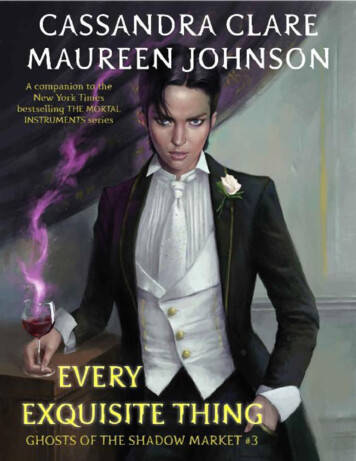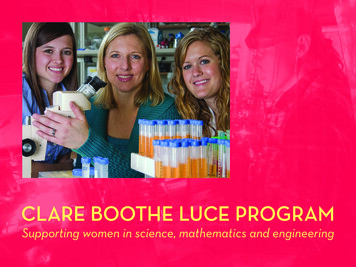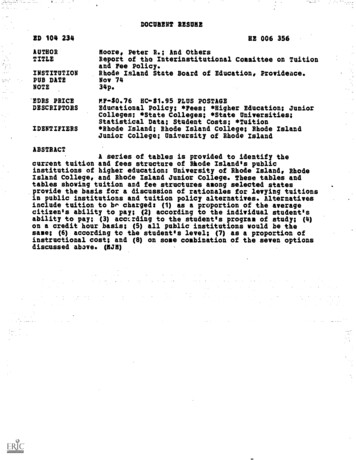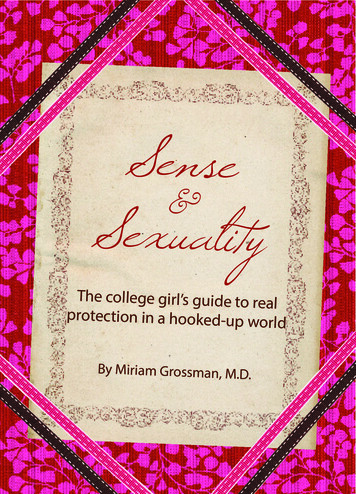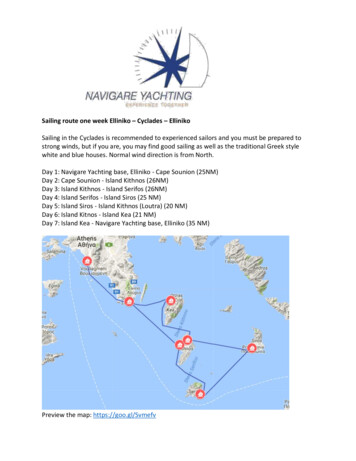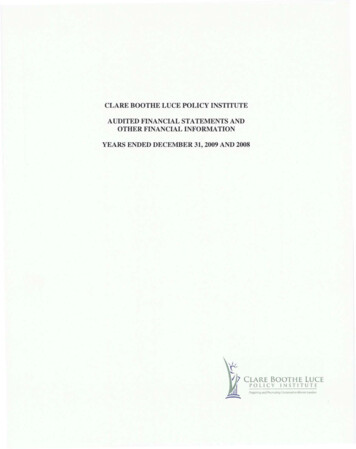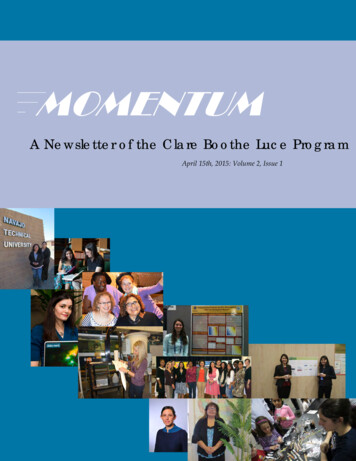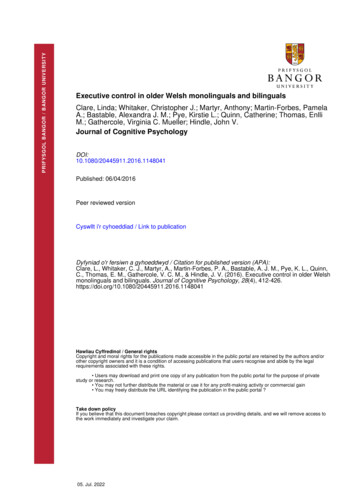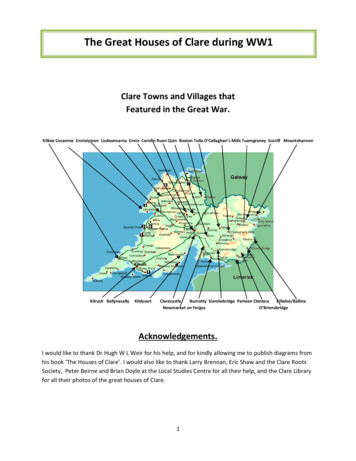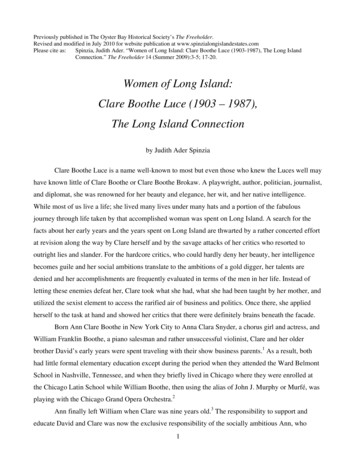
Transcription
Previously published in The Oyster Bay Historical Society’s The Freeholder.Revised and modified in July 2010 for website publication at www.spinzialongislandestates.comPlease cite as:Spinzia, Judith Ader. “Women of Long Island: Clare Boothe Luce (1903-1987), The Long IslandConnection.” The Freeholder 14 (Summer 2009):3-5; 17-20.Women of Long Island:Clare Boothe Luce (1903 – 1987),The Long Island Connectionby Judith Ader SpinziaClare Boothe Luce is a name well-known to most but even those who knew the Luces well mayhave known little of Clare Boothe or Clare Boothe Brokaw. A playwright, author, politician, journalist,and diplomat, she was renowned for her beauty and elegance, her wit, and her native intelligence.While most of us live a life; she lived many lives under many hats and a portion of the fabulousjourney through life taken by that accomplished woman was spent on Long Island. A search for thefacts about her early years and the years spent on Long Island are thwarted by a rather concerted effortat revision along the way by Clare herself and by the savage attacks of her critics who resorted tooutright lies and slander. For the hardcore critics, who could hardly deny her beauty, her intelligencebecomes guile and her social ambitions translate to the ambitions of a gold digger, her talents aredenied and her accomplishments are frequently evaluated in terms of the men in her life. Instead ofletting these enemies defeat her, Clare took what she had, what she had been taught by her mother, andutilized the sexist element to access the rarified air of business and politics. Once there, she appliedherself to the task at hand and showed her critics that there were definitely brains beneath the facade.Born Ann Clare Boothe in New York City to Anna Clara Snyder, a chorus girl and actress, andWilliam Franklin Boothe, a piano salesman and rather unsuccessful violinist, Clare and her olderbrother David’s early years were spent traveling with their show business parents.1 As a result, bothhad little formal elementary education except during the period when they attended the Ward BelmontSchool in Nashville, Tennessee, and when they briefly lived in Chicago where they were enrolled atthe Chicago Latin School while William Boothe, then using the alias of John J. Murphy or Murfé, wasplaying with the Chicago Grand Opera Orchestra.2Ann finally left William when Clare was nine years old.3 The responsibility to support andeducate David and Clare was now the exclusive responsibility of the socially ambitious Ann, who1
seemed to care little for David or his prospects. She poured her efforts into marrying and finding acomfortable economic and social position for herself through which she could then “launch” Clare.4Positioning Clare for that launch was to be her next big project. Using money she had inherited fromher father John Schneider (Snyder), Wall Street returns on the money William had sent as support,albeit irregularly, and her earnings as a saleslady in a jewelry store, Ann entered David in militaryschool in Wisconsin and took Clare on a tour of Europe to expose her to culture and the Continent.5 Nomatter their financial situation, no matter where they slept and ate, no matter that they traveled secondclass, the masks of society were firmly in place and Ann was leading Clare ever “upward.”6 It was onthis trip that Ann met Joseph Jacobs whose wealth derived from the growing success of Firestone Tireand Rubber Company. According to Clare, Jacobs may well have proposed to Ann on the voyagehome. He was from that day on a part of Ann’s life and provided for her and the children.7Clare Boothe [driving] with Elizabeth “Buffy” Cobbin front of St’ Mary’s Cathedral School, Garden City, New York, c. 1916Although educating Clare does not seem to have been her real goal, Ann managed to enrollClare in St. Mary’s Cathedral School for Girls in Garden City. The fact that Clare’s grandfather Boothewas a clergyman allowed Clare to attend the diocesan school utilizing the school’s tuition courtesypolicy.8 As a scholarship student at St. Mary’s Clare was at a disadvantage socially but she was a goodstudent who escaped into writing and books, reading everything in sight, especially philosophy, poetry,and the classics. She consumed all that she encountered with quiet enthusiasm, filing it away for futureuse.Biographies frequently state that Clare attended St. Mary’s Cathedral School and subsequentlyattended and was graduated from Castle School, also referenced as Miss Mason’s School, in Tarrytown, New York, at the age of sixteen.9 While Clare did attend St. Mary’s from 1916 to 1918 and2
did transfer to the Tarrytown school, leaving the school at the top of her class in June 1919, she did nottechnically “graduate” from high school and joked about the eight or nine honorary college degreesconferred upon her in light of the three years of high school she had completed.10Ann pursued marriage for herself once Clare had completed an education adequate for socialacceptance. Although she continued to have a close relationship with Jacobs, a relationship which didnot end until her death, she turned down his proposal of marriage stating that his religion would be animpediment to her plans for Clare.11 In the fall of 1919 Ann underwent an emergency appendectomyand fell in love with her doctor, the head of internalmedicine and chief of staff of Greenwich Hospital inConnecticut. Ann married Dr. Albert E. Austin and moved,with her children, to Old Greenwich, Connecticut.12 Shereturned to her agenda and the launch of Clare was againunderway.Clare [left], Dr. Albert Austin, and Ann Snyder [Boothe]Austin either at their departure for Europe, November1920, or upon Clare and Ann’s return in 1921Dr. and Mrs. Austin and Clare set off on a tour of Europe in November 1920, this time in style. Whilesailing home on the Olympia, Ann, ever the opportunist, positioned deck chairs next to gossipcolumnist and author Elsa Maxwell and socialite suffragist Alva Smith [Vanderbilt] Belmont.Charmed by Clare and having lost her young assistant Inez Mulholland, the dynamic suffrage leaderrecruited Clare into the woman’s rights movement.Clare was invited to the Belmont estate BeaconTowers in Sands Point, Long Island, and, later toSeneca Falls, NY, July 1923Clare at far left in second row rightbehind Alice Paul; Alva Vanderbilt Belmontthird from right in front row3
the Woman’s Party Headquarters in Washington to meet Alice Paul.13. As Alva’s assistant andpersonal secretary, she accompanied Mrs. Belmont to Seneca Falls, New York, to celebrate theseventy-fifth anniversary of the Woman’s Rights Conference. Resplendent in helmet and goggles,Clare dropped leaflets from a World War I Jenny while flying over nearby Schenectady to advertisethe anniversary celebration. She contributed youth and vitality and did attract attention to the cause asAlva Belmont had calculated.14Clare had also met the James Stewart Cushmans on board the Olympia. In June of 1922Cushman, a socially-prominent philanthropist invited Clare to hear the dynamic young clergymanHarry Emerson Fosdick preach at the Riverside Church in Manhattan. Seated beside her was GeorgeTuttle Brokaw. At the conclusion of the service, George drove Clare to the station to catch the trainback up to Greenwich and drove to Greenwich the next week to visit her and meet Dr. and Mrs.Austin.15 In 1923 Clare married George, twenty-three years her senior, he forty-three and she twenty.Clare had not chosen to marry Brokaw; her mother brokered the society marriage. George was the sonof Isaac Vail Brokaw, who with his brother William Vail Brokaw had founded the Brokaw BrothersClothing Company. Its profits, beginning as a supplier of uniforms for the Union Army during theCivil War, created a fortune that resulted in the establishment of several estates on Long Island’s NorthShore.16 George, an attorney, playboy, and troubled alcoholic, and Clare, a naïve child now “societymatron,” moved into the large c. 1910 Neo-Georgian house onMiddle Neck Road in Sands Point formerly known as The Lindens,a house that had been designed by Augustus N. Allen for JuliusFleischmann, an heir to the Fleischmann yeast fortune. Clare maynot have found happiness here, but her mother Ann certainly feltthat Clare had been successfully launched into society and shecould cross another thing off her list. George sold the Sands Pointhouse in 1926 for a reported 300,000 and the Brokaws builtSunnybrook on Wolver Hollow Road and Ripley Lane in UpperBrookville.17George Tuttle and Clare BootheBrokaw on their return fromEurope, 1923Clare suffered several miscarriages, credited by some, including George’s second wife Frances, toGeorge’s violent behavior when inebriated.18 Always contrite after these episodes, George pleadedwith Clare to remain but finally, after six years of marriage, Clare moved out and went to live at the4
Stanhope Hotel in Manhattan with their daughter Ann, then four years old. This temporary andunsatisfactory arrangement ended with a Reno divorce in1929. Clare had respected the unreasonable request madeby George’s mother that she not leave George until thesenior Mrs. Brokaw had died.19 On a 25,000 after-taxesannual income, a modest alimony considering George’sworth was estimated at about 12 million, Clare BootheBrokaw rented a penthouse apartment at 444 East 52ndStreet in Manhattan and began life again.20Clare’s first job was as a caption writer for CondéNast’s Vogue Magazine for which she was not paid. Afew weeks after she started the job Nast viewed her workand put her on the payroll at a 35-a-week salary.21 Acareer was born; she moved from Vogue to Vanity FairThe Brokaws during happier daysand in 1933 she became managing editor of Vanity Fair.In 1933, while still at Vanity Fair, Clare had written the book Stuffed Shirts. Writing ideascontinued to percolate in her head precipitating Clare’s decision to write full time. She resigned fromthe magazine in 1934 and threw herself into the life of a playwright, writing Abide With Me in 1935,generally considered to be a thinly-disguised story of her marriage to Brokaw; the highly successfuland somewhat biographical The Women in 1936; and Kiss the Boys Goodbye, which was named one ofthe ten best plays of 1938.22 Margin of Error, published in 1939, was followed in 1940 by Europe inthe Spring. Additionally, she wrote the screenplay for Come to the Stable in 1949, which was nominated for an Academy Award, and in 1951 she wrote the stage play Child of the Morning. In 1952Saints for Now was published for which she is listed as editor, not author.As she changed hats from her role as magazine editor to author, Clare and Bernard Baruchbecame close and devoted friends or, as some might say, the next man entered her life. He and Clarewere both intimately involved in FDR’s “New Deal” at the highest level. Baruch, a successful speculator and financier, had created a persona of statesman and advisor in much the way Clare invented andreinvented herself. Sitting on a park bench in Lafayette Park across from the White House offeringintellectual advice to presidents, Baruch became a character listened to by most, understood by some,and acknowledged positively by both the political world and society. Since he would not divorce hiswife, who was mentally ill, his relationship with Clare seemed hopeless. Hopeless it was not and theirclose relationship continued until his death in 1965. Baruch’s estate Hobcaw Barony in South Carolina5
adjoined the Luces’ estate Mepkin Plantation where they had built their home Claremont. One mightsay that Bernard Baruch was to Clare as Joseph Jacobs had been to her mother Ann. Ironically,Baruch’s wife died just six months after Clare married Henry Robinson Luce, the publisher of Time,Fortune, Life, and Sports Illustrated.23 Clare and “Harry,” as he was known, were married onNovember 23, 1935, shortly after Luce had been granted a divorce from his wife Lila R. Hotz Luce.24Harry and Clare seemed relatively happy in the beginning of their marriage but despite the fact thatthey worked well together, Harry lacked the vitality and intellectuality to keep pace with Clare. Sheturned to Baruch, thirty-three years her senior, for the rest of his life. Bernard Baruch died in 1965 atthe age of ninety-four; Harry died two years later as the age of sixty-eight.The Long Island years were now part of the distant, often revised, past. Clare became a nationalfigure. After her work with the Roosevelt administration, Clare returned to journalism, traveling andwriting as a foreign correspondent for Life, teaming with her husband Harry Luce. In 1942 she againtook up residency in Connecticut to run for the seat in the United States House of Representativesformally held by her stepfather Dr. Albert E. Austin, representing Connecticut’s Fourth CongressionalDistrict. She won and was re-elected in 1944. Appointed by President Eisenhower in 1953 asAmbassador to post-war Italy, the first woman to receive anambassadorial appointment to the government of a major power,Clare’s “stateswomanship” was remarkable for its successes andits controversy. She served until 1957. In 1973 she was appointed to the Foreign Intelligence Advisory Board by PresidentNixon and continued to serve on that board under both Presidents Ford and Reagan. Clare Boothe Luce lived out her laterlife in Hawaii and died at the age of eighty-four in Washington,DC, on October 9, 1987.Clare Boothe Luce in her library.ENDNOTES1.According to Clare, William’s father, born Booth, added the e to the family name to distancehimself and his progeny from John Wilkes Booth to whom the family may or may not have actuallybeen related. Clare thought the small deception was infinitely amusing and that it was ultimatelyineffective since a large percentage of correspondents throughout her life and at least one biographermisspelled Boothe. Wilfred Sheed, Clare Boothe Luce. (New York: Dutton Publishing Inc., 1982),6
p. 38. Although members of the Boothe family have denied Clare’s story in regard to the addition othee, genealogical records show that a terminal e was used by their ancestors prior to 1840 and thenreinstated in the era of William’s father which, of course, does not confirm Clare’s explanation of thechange in spelling, nor does it disprove it. Sylvia Jukes Morris, Rage to Fame: The Ascent of ClareBoothe Luce. (New York: Random House, 1997), pp. 20, 495.The preoccupation with and seemingly endless speculation about Clare’s legitimacy hinges onthe lack of tangible evidence in the form of a marriage certificate for William and Ann. Wikipedia’sbiographical entry for Clare Boothe Luce begins the section on her early life “Ann Clare Boothe, theillegitimate child of ” William had been previously married to Laura O. Brauss from whom he wasnot legally divorced until April 1907. The document states that he and Laura, who had been married inNew Jersey on November 7, 1886, had not been cohabitating since 1901. A New York State divorcedecree was granted to Laura on the grounds of adultery. According to Morris, at that time he waslegally prohibited from remarrying in New York State “until the said Laura O. B. Boothe shall beactually dead.” Morris, pp. 24-25. Since Laura went on to have a successful career as a writer for theNew York Sunday World, William would not have been free to marry Ann under New York State laweven after the 1907 divorce. Morris, pp. 495-96. One source says that William and Ann eloped in 1894.Ralph G. Martin, Henry and Clare: An Intimate Portrait of the Luces. (New York: G. P. Putnam’sSons, 1991), p. 28. Other sources repeat Clare’s insistence that her parents were married in a civilceremony in 1902. David was born in March 1902 and Clare was born on March 10, 1903, accordingto the birth certificate signed by Dr. George A. Leek. Morris, p. 15. Clare’s steadfast position that herparents were married in 1902 is understandable. Even if they had been married in a civil ceremony,Ann’s Roman Catholic parents William and Louisa Schneider (Snyder), who were vocal in declaringtheir daughter to be “living in sin,” would not have recognized the civil marriage any more than theywould have recognized a “common law” marriage; even if William had divorced Laura beforemarrying Ann, there could be no acceptance of their daughter’s union with a divorced man of anotherreligion. William’s father John William Thomas Boothe, a fundamentalist Baptist minister, also did notrecognize William and Ann’s union as a marriage. In addition to being vehemently anti-papist, PastorBoothe despised the theater and theater people. Stephen Shadegg, Clare Boothe Luce: A Biography.(New York: Simon and Schuster, 1970), pp. 12-13.Carolyn Wells Kraus, “A Discourse of Female Bastardy,” University of Michigan, PhD. thesis,1998.2.Martin, pp. 29-31, and Morris, pp. 28-29, 31-36.3.Morris, p. 39.Stephen Shadegg, p. 26, states that Clare did not know whether her parents were actuallydivorced. Wilfred Sheed, p. 39, states that her parents were divorced in 1913. Both biographers hadaccess to Clare Boothe Luce for verification. Ralph Martin, p. 31, states that Ann Clare Snyder Boothedivorced William citing desertion and was granted a formal divorce on those grounds in 1913. Theseconclusions are highly suspect since no divorce decree was found in Clare’s personal papers, althoughthe divorce papers for the dissolution of William’s marriage to Laura O. Brauss were present. And, asstated in endnote #1, there is no documentary evidence of William having married Ann after his 1907divorce from Laura. Statements dating and confirming a legal divorce between Ann and William cannot be confirmed.4.William Franklin Booth claimed to have sent money to Ann for the support of David and Clare, aclaim that Clare dismissed based on the poverty in which Ann and the children lived. Sheed, p. 40.Clare claimed to have met her father on a train as she was traveling down from Connecticut toNew York City to attend a play with a friend. According to Clare, he sat down next to her, identified7
himself as they approached the tunnel to Grand Central Station, they talked briefly, and she never sawhim again. She claimed that she took the next train back home and confronted her mother who had toldClare and David that their father had died ten years earlier. Clare also said that she supported her fathernear the end of his life when his music school in California had to be closed because of his illness.Shadeeg, pp. 24-26. Others deny her claims of support. Morris, pp. 150-53.5.Shadegg, p. 16.Sylvia Jukes Morris, who interviewed Clare and who had unrestricted access to Clare’s papers,states that Clare admitted that by 1913 her mother had probably become a call girl. Morris, p. 44.Whatever, the truth of the matter, there was no doubt that their standard of living ebbed and flowedwith the comings and goings of Ann Snyder Boothe’s gentlemen friends. Sheed, p. 40.6.Shadegg, p. 16.7.Sheed, pp. 40-41.8.Martin, p. 34.9.Shadegg, pp. 21-24 and Sheed, p. 46.10Sheed p. 46.11.Sheed p. 41.The relationship between Ann Clara Snyder Boothe and Joseph [alternately referred to as Joel]Jacobs continued after her marriage to Dr. Austin. She was with Jacobs when she died in 1938; the carin which they were riding was struck by a train when it became stalled on the tracks at a railroadcrossing.12.Shadegg, pp. 27-28.13.Shadegg, pp. 32-33 and Sheed, p. 52.For information on Alva Smith Vanderbilt Belmont’s estate Beacon Towers, see Raymond E. andJudith A. Spinzia, Long Island’s Prominent North Shore Families: Their Estates and Their CountryHomes, vol. I. (College Station, TX: VirtualBookworm, 2006) – Belmont entry. See also Raymond E.and Judith A. Spinzia, Long Island’s Prominent South Shore Families: Their Estates and TheirCountry Homes in the Towns of Babylon and Islip. (College Station, TX: VirtualBookworm, 2006) –Vanderbilt entry – for information on the Vanderbilt’s Oakdale estate Idlehour. Oliver Hazard Perryand Alva Smith Belmont’s estate Brookholt in East Meadow is discussed in a forthcoming book byRaymond E. and Judith A. Spinzia, Long Island’s Prominent Families in the Town of Hempstead:Their Estates and Their Country Homes.See also Raymond E. Spinzia, “In Her Wake: The Story of Alva Smith Vanderbilt Belmont.” TheLong Island Historical Journal 6 (Fall 1993), pp. 96-105.14.Shadegg, pp. 34-37.15.Shadegg, pp. 34, 37-38.8
16. For information on other members of the Brokaw family, see Raymond E. and Judith A. Spinzia,Long Island’s Prominent North Shore Families: Their Estates and Their Country Homes, vol. I.(College Station, TX: VirtualBookworm, 2006) – Brokaw entries.The Brokaw name had been changed from Broucard to Brokaw. The New York Times March 20,1939, p. 17.17.Spinzia, Long Island’s Prominent North Shore Families, vol. I, p. 93.The Sands Point estate on Middle Neck Road was subsequently owned by Charles Schwartz andpurchased in 1938 by Alfred Gwynne Vanderbilt II.The Long Island Society Register, 1929 lists the Brokaws’ address as Valley Road, Brookville.Wolver Hollow Road is said to have been casually known as “Valley Road” by locals which couldaccount for the Register address entry. The Brokaws were living at Sunnybrook at the time of theirdivorce.The Hagstrom’s Street, Road and Property Ownership Map of Nassau County, Long Island, NewYork, 1946 lists Henry Fonda as the owner of the Brookville house on forty-six acres.18. Henry Fonda in collaboration with Howard M. Teichmann, Fonda: My Life. (New York: NALPublishers, 1981), p. 119.19.Shadegg, pp. 46-47 and Martin, pp. 80-81.Eloise Elvira Gould Brokaw, George’s doting mother, was said to have been fully aware of hisabusive personality and behavior.20.Shadegg, p. 49.The Brokaw family brokered the divorce settlement since George had not chosen to give Clare afinancial settlement nor had he chosen to establish a trust fund for their daughter Ann Clare Brokaw.Shadegg, p. 49. At Ann’s unfortunate death at age nineteen in 1944, the 425,000 trust fund wasawarded to Frances de Villers Brokaw, George’s daughter by his second marriage to Frances FordSeymour, the daughter of Eugene Ford and Sophie Mildred Bower Seymour.George died in 1935, in a swimming pool of a sanitarium in Hartford, CT, where he was beingtreated for a nervous breakdown and alcoholism, just four years after he had married Frances, twentyeight years his junior. Shadegg, p. 96. He was fifty-five at his death; Frances was twenty-seven. Shesubsequently married the actor Henry Fonda with whom she had two children Peter and Jane (baptizedLady Jayne Seymour Fonda). Frances committed suicide in 1950 in Craig House, a sanitarium inBeacon, NY, shortly after Henry Fonda had requested a divorce in order to marry Susan Blanchard, thedaughter of Dorothy Hammerstein and step-daughter of Kings Point resident Oscar Hammerstein II.Peter Collier, The Fondas: A Hollywood Dynasty. (New York: Berkeley Books, 1992), p. 65 andFonda, pp. 194, 196-202.21.Shadegg, p. 55.22. The Women was made into a film in 1939. George Cukor directed an all-female cast includingJoan Crawford, Norma Shearer, and Rosalind Russell. In 1956 it was remade as a musical called “TheOpposite Sex” in which the single-gender concept of the stage play and the first film was abandoned.23.Sheed, p. 63.24.The Los Angeles Times November 24, 1935, p. 1.9
photo credits:Culver Pictures, 3 topFotogram, 5George Karger, Life Magazine, 6Library of Congress, 3 bottomSylvia Jukes Morris, 2UPI / Bettman, 4Copyright by Judith Ader Spinzia, 200910
Clare in St. Mary's Cathedral School for Girls in Garden City. The fact that Clare's grandfather Boothe was a clergyman allowed Clare to attend the diocesan school utilizing the school's tuition courtesy policy.8 As a scholarship student at St. Mary's Clare was at a disadvantage socially but she was a good
